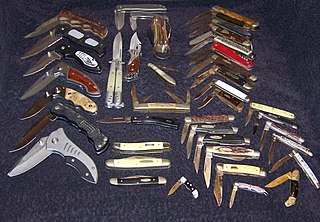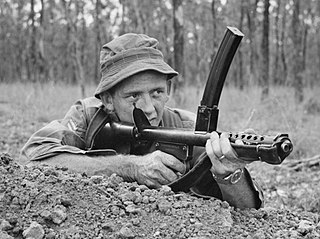
Gun safety is the study and practice of using, transporting, storing and disposing of firearms and ammunition, including the training of gun users, the design of weapons, and formal and informal regulation of gun production, distribution, and usage, for the purpose of avoiding unintentional injury, illness, or death. This includes mishaps like accidental discharge, negligent discharge, and firearm malfunctions, as well as secondary risks like hearing loss, lead poisoning from bullets, and pollution from other hazardous materials in propellants and cartridges. There were 47,000 unintentional firearm deaths worldwide in 2013.

A revolver is a repeating handgun that has at least one barrel and uses a revolving cylinder containing multiple chambers for firing. Because most revolver models hold up to six rounds of cartridge before needing to reload, revolvers are also commonly called six shooters.

Concealment devices or diversion safes are used to hide things for the purpose of secrecy or security. They are made from an ordinary household object such as a book, a soda can, a candle, a can, or something as small as a coin. The idea is that such an inconspicuous object would not be expected to contain anything of worth.

Electrical wiring is an electrical installation of cabling and associated devices such as switches, distribution boards, sockets, and light fittings in a structure.

A pocketknife is a knife with one or more blades that fold into the handle. They are also known as jackknives (jack-knife), folding knives, or may be referred to as a penknife, though a penknife may also be a specific kind of pocketknife. A typical blade length is 5 to 15 centimetres.

A tactical light is a flashlight used in conjunction with a firearm to aid low-light target identification, allowing the marksman, law enforcement officer or soldier to simultaneously aim a weapon and illuminate the target. Tactical lights can be handheld or mounted to the weapon with the light beam parallel to the bore. Tactical lights also serve a role as a method of non-lethal force, used to temporarily blind and disorient targets or, in the case of a large metal Maglite with D batteries, police can use the flashlight as a billy club. Features particularly associated with tactical lights include shock resistance, reliability, lightweight construction and powerful, long-lasting batteries, and high light intensity. Tactical lights may have optional filters to produce colored light, e.g., red, to not attract bugs, or may emit only infrared radiation for use with night vision equipment. A sighting laser may also be added to a weapon-mounted tactical light.

A handgun holster is a device used to hold or restrict the undesired movement of a handgun, most commonly in a location where it can be easily withdrawn for immediate use. Holsters are often attached to a belt or waistband, but they may be attached to other locations of the body. Holsters vary in the degree to which they secure or protect the firearm. Some holsters for law enforcement officers have a strap over the top of the holster to make the handgun less likely to fall out of the holster or harder for another person to grab the gun. Some holsters have a flap over the top to protect the gun from the elements.

A latch or catch is a type of mechanical fastener that joins two objects or surfaces while allowing for their regular separation. A latch typically engages another piece of hardware on the other mounting surface. Depending upon the type and design of the latch, this engaged bit of hardware may be known as a keeper or strike.

The Hi-Point Model JHP is a polymer-framed, semi-automatic, blowback-operated pistol manufactured by Hi-Point Firearms.

A trigger is a mechanism that actuates the function of a ranged weapon such as a firearm, airgun, crossbow, or speargun. The word may also be used to describe a switch that initiates the operation of other non-shooting devices such as a trap, a power tool or a quick release. A small amount of energy applied to the trigger leads to the release of much more energy.

Paris Theodore was an American inventor of gun holsters and firearms and shooting techniques used by government agents and police departments in the U.S. and abroad, as well as by the fictional James Bond.

The 9×19mm Parabellum F1 is an Australian submachine gun manufactured by the Lithgow Small Arms Factory. First issued to Australian troops in July 1963, it replaced the Owen machine carbine.

A police duty belt is a belt, typically constructed of nylon or leather used by police, prison and security officers to carry equipment easily in a series of pouches attached to the belt, in a readily-accessible manner, while leaving the hands free to interact. This belt can carry any number of useful items, ranging from handcuffs to guns.

A baton is a roughly cylindrical club made of wood, rubber, plastic, or metal. It is carried as a compliance tool and defensive weapon by law-enforcement officers, correctional staff, security guards and military personnel.

A gun safe is a safe designed for storing one or more firearms and/or ammunitions. Gun safes are primarily used to prevent access by unauthorized or unqualified persons, for burglary protection and, in more capable safes, to protect the contents from damage by flood, fire or other natural disasters.
The following are terms related to firearms and ammunition topics.
A paddle holster is a holster for a handgun whose method of securing the holster to the wearer utilizes a flat, concave shaped piece of plastic or stiffened leather designed to be worn against the body inside of the pants. The broad surface area of the "paddle" and the material from which it is made use friction to prevent the holster from being pulled up and away when the handgun is drawn.
Criminal possession of a weapon is the unlawful possession of a weapon by an individual.

In firearms, a safety or safety catch is a mechanism used to help prevent the accidental discharge of a firearm, helping to ensure safer handling.

A bolt snap is a type of snap hook with a manually operated bolt action slide gate of medium security used to clip a light load to a ring, eye, loop or bight to temporarily secure or suspend an object. They are used for a wide variety of applications including dog leads and for clipping scuba equipment to the diving harness. A similar but more secure device used to attach sails to a stay is known as a piston hank. It differs from a snap shackle in that the load is not carried by the gate. The bolt snap must be actively operated by the user to clip or unclip, and is not easily snagged or unintentionally clipped or unclipped by pressing or bumping against the surroundings.

















